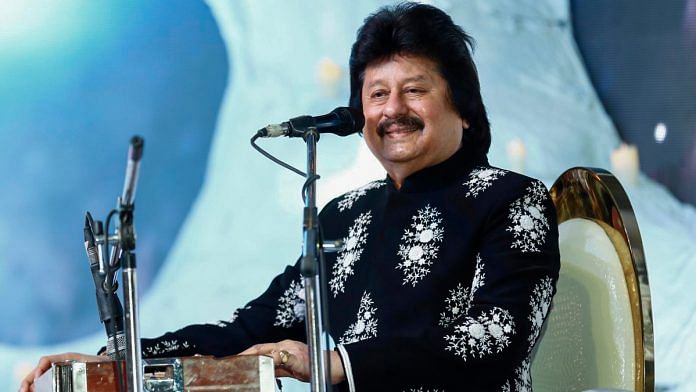For the middle-class Indian in the 1980s, ghazal suddenly became accessible, relatable, and hummable because of three singers: Jagjit Singh, Pankaj Udhas, and Chitra Singh. Two of them are now dead.
Pankaj Udhas, who passed away on 26 February after a prolonged illness, was a singer whose melancholic voice resonated with the grief-filled hearts of many North Indians. With a drink and chakhna in hand, or at a Mughlai food restaurant, his ghazals provided comfort and solace. He brought the ghazal home. It was no longer the preserve of the Urdu-waxing cultural elite who followed Pakistani singers. Pankaj Udhas and Jagjit Singh sang in Hindustani, and for the 1980s cassette generation, their music was a welcome break from Bollywood’s disco wave.
From ‘Aur Ahista Kijiye Baatein’ to ‘Chitthi Aayee Hai’ to ‘Deewaron Se Milkar Rona’, Pankaj Udhas’s voice was distilled melancholy.
“Poets like Mirza Ghalib wrote in a mix of Persian, Arabic and Urdu that was difficult for the common man to decipher. I started reading various poets and my attempts to simplify the language culminated in ghazals like ‘Aap jinke kareeb hote hain, wo bade khushnaseeb hote hain,” he said in a 2019 interview.
Rise of a ghazal legend
Udhas launched his career with the ghazal album ‘Aahat’ (1980) and followed it up with three other critically acclaimed albums, ‘Mukarar,’ ‘Tarrannum,’ and ‘Mehfil.’ But it was his hit song ‘Chitthi Aayee Hai’ from the movie Naam (1986) that made him a household name. The song was picked as one of the top 100 songs of the millennium by BBC Radio worldwide.
Laden with emotion, the song is about separation, love, and longing—evoking a sense of nostalgia when receiving a letter from a loved one who is far away. It’s all the more poignant today with the advent of DMs and instant messaging. In an interview, Udhas recalled how he met Raj Kapoor on a flight back to Mumbai from Jaipur. When he went to touch his feet, Kapoor told him, “Pankaj Udhas has become immortal.” Puzzled, Udhas simply thanked the actor for his blessings. “And he [Raj Kapoor] said, ‘No, Chitthi Aayi Hai’.”
In fact, it was his ghazals that brought the famous song into his kitty. Recalling the incident in a 2017 interview, Udhas explained how actor Rajendra Kumar “was impressed by my ghazals and wanted to include one of them in the film”.
“The offer to sing in Naam came quite like a bolt from the blue,” he had told The Hindu.
With their distinctive style, Udhas and Jagjit Singh popularised ghazals, turning it into a profitable market. Udhas did not need the face of an actor to sing for films, as evidenced by hits like ‘Chupke Chupke Sakhiyon Se Woh’ (featuring John Abraham), and ‘Peene Walon Suno’, where he appeared as himself.
Udhas did not hesitate to experiment with his singing talent while remaining true to his roots in ghazals. Hits like ‘Jeeyein Toh Jeeyein Kaise’ from Saajan (1991) and ‘Na Kajre Ki Dhar’ from Mohra (1994) solidified his success. Despite offers, his focus remained on ghazals. His album ‘Afreen’ was released in an extended 90-minute double-cassette format.
In the late ’90s, he became a raging sensation with his album ‘Nasha’—whose songs were the laments of an alcoholic. They popularised words like ‘saqi’ and ‘paimana’ for the younger generation, who could now listen to alcohol-related songs even in the presence of elders. All of a sudden, ‘sharab’ wasn’t a taboo word.
The rise of MTV and Channel V in the 1990s did little to dent his popularity. Udhas approached MTV with his company Music India, urging them to air his videos. In 1999, they agreed to air his ghazal ‘Phir Haath Mein Sharaab Hai’’ from the album ‘Nasha’.
If his contribution to Bollywood popularised ghazals, then the film industry’s current avatar is also responsible for its decline. In a 2021 interview with Hindustan Times, he expressed sorrow at the state of ghazals in popular culture today.
“What has happened today is that the entire filmmaking has changed. Cinema is no more about fantasy; it’s very realistic and practical…Most of the songs used in films these days are either dance tracks or background numbers,” he had said.
But always looking ahead, he predicted that OTT was a space where ghazals could shine again.
Also read:
His life
Padma Shri award winner Pankaj Udhas was born on 17 May 1951, in Jetpur, Gujarat. But music was always part of his life. Both his grandfather, who was the first graduate from their village, and his father, a government servant, learnt to play the dilruba from the renowned veena player Abdul Karim Khan. In interviews, he recalled his mother had a beautiful voice and would sing at family gatherings.
The family later moved to Mumbai, where Udhas chased his love for music and ghazals. He first performed on stage at the age of five, singing the famous song ‘Ai Mere Watan Ke Logon’ by Lata Mangeshkar during the India-China war.
Udhas always stayed true to his music while also evolving with time. His approach to sound, poetry, and composition always stayed fresh and emotionally resonant. His music still holds sway in pop culture, with hits like ‘Ghungroo Toot Gaye’ and ‘Sone Jaise Baal Hain Uske’.
“Woh din gaye, woh sham ki sohbat chali gayi,
Ab roz dil jalane ki nobat chali gayi…”
(Edited by Prashant)



